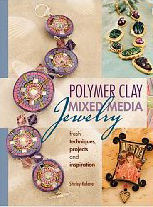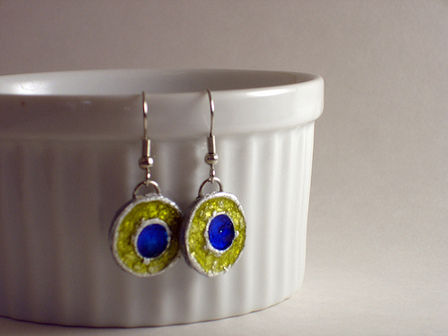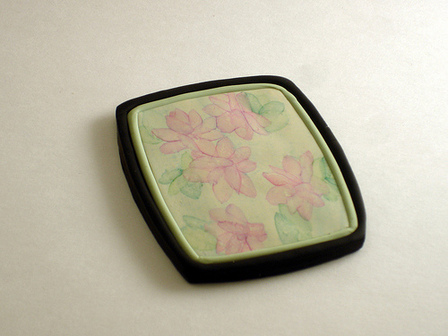Review: Polymer Clay Mixed Media Jewelry by Shirley Rufener
I'm embarrassed to admit it, but I'm a bit of a supply junkie. In theory, I like that all you need for polymer clay is your fingers. But in reality, I'm always tempted by the newest gadget, tool, or supply. I'll find some excuse to justify getting it — but then, more often than I like to admit, that thing will sit for months or even years unused in my craft closet. I feel guilty about it. But it doesn't stop me from doing it again the next time a really interesting-sounding product comes out.
I suspect it's a pretty common situation for crafters. I've known scrapbookers with stacks and stacks of patterned papers (none of which they wanted to actually use) and rubber stampers with literally thousands of stamps. As long as you're actually using those things, it's really not a problem. But collecting supplies you never use can weigh you down — and you don't want anything weighing down your creativity!
Shirley Rufener's Polymer Clay Mixed Media Jewelry is just the book for supply junkies. This book's projects incorporate some of those supplies you might have bought but never gotten around to using: things like chalks, alcohol inks, metal leaf, embossing powders, custom stamp-making kits, precious metal clay, resin, and more.
There are a couple of things that really set this book apart. First, it has an excellent introduction. At 22 pages, it's longer than normal, but it includes instructions for using polymer clay and precious metal clay, plus the basics of jewelry assembly. I especially liked the examples of matching end cap and closures made from polymer clay. I also found the introduction to precious metal clay helpful (that's one of those supplies I've had in my closet and have been afraid to use). Rufener has instructions for working with it and firing it, plus step-by-step instructions for making your own metal clay bails. She also has a nice picture showing the different effects you can achieve using liver of sulfur patina.
The other thing that sets this book apart is its wide variety of projects and styles. Rufener says in the intro that she included a variety of jewelry styles "in the hope that something will catch the eye of a very diverse group of readers, crafters, and artists." That's a nice goal for an author to have, and I think she succeeded. While there were some projects that didn't appeal to me at all (but presumably appeal to someone out there with different tastes), I did find several projects I really liked. She encourages readers to make the projects their own — use favorite colors and experiment with embellishments. "Allow yourself to unleash the creativity inside."
The Projects
The book has 18 projects. Here's a list, along with the materials and techniques each one features:
- Altered Pastel Brooch: pastel chalks, translucent clay, and a backfilling technique
- Organic Bead Bracelet: pastel chalks, rubber stamps (I love the way she creates the domed strips on this one.)
- Chalk Pod Floral Pendant: pastel chalks, resin
- Love Letters Collage Pin: polymer clay transfer, pastel chalks, wire framing, gold leaf
- Curved Tile Bracelet: curved polymer clay transfer, pastel chalks with Fantastix applicator (I like her method for creating beading channels.)
- Etched Leaf Pin: silver leaf, alcohol inks, and a cool masking technique
- Faux Dichroic Glass Necklace: gold leaf, alcohol inks, EnviroTexLite, and a nice method for creating your own bezels
- Asian Influence Dangles: embossing powders, rubber stamping
- Sicilian Spice Bracelet: liquid clay, alcohol inks, metal leaf, and carving a mold from baked polymer clay
- Champleve Molded Earrings: liquid clay, alcohol inks, metal leaf, and molding
- Cabochon Ring: metal clay and setting crystals in polymer clay
- Champleve Seahorse Necklace: metal clay, liquid clay, alcohol inks, silver leaf, and using a custom stamp-making kit
- Lots of Dots Charm Bracelet: metal clay, silver leaf
- Mosaic Collage Bracelet: mosaic with polymer clay and rhinestones
- Bird on a Limb Mosaic: mosaic
- Mosaic Lapel Brooch: 3-D mosaic
- Felt Bead Neckpiece: polymer clay cane bead caps for felt beads
- Galaxy Bead Bracelet: gold leaf and bead roller tricks
While I like many of the projects, the project instructions are just so-so. I found a lot of problems — things like typos, errors, pictures out of order, and confusing instructions. For example, there were a couple of places where I was almost sure she was telling me to sand an unbaked clay piece. Most of the unclear stuff can be figured out with a couple of re-reads, especially for folks who are familiar with polymer clay. But I think the book really would have benefited from a more thorough editing job.
And while supply junkies may enjoy finding projects they can use their stockpiles on, others may be a little overwhelmed at the long supply lists. I have a pretty well-stocked craft room, and there were quite a few of the supplies that even I don't have. In some cases, it seemed to go a little overboard — for example, requiring a white pencil to sketch a pattern to carve into the clay. While more experienced clayers may know of other supplies that would work just as well, I worry that beginners may feel the need to buy supplies that aren't really necessary.
And that's another thing. Rufener says the book is aimed at beginners and intermediate crafters (though she hopes accomplished artists will find mixed media applications and techniques too). Even with its extensive introductory info, I'm not sure this book would be good for beginners. The supply lists are awfully long, and the projects are all fairly complex. Combine that with the confusion some of the poorly-edited parts caused me, and I'm just not sure beginners will find success with these projects.
But I do think intermediate — and probably advanced — clayers will find something useful here. There are some really unique ideas included in the projects. She also includes various helpful tips for working with clay... some that I've figured out over the years, but others that were new to me.
My Results
This book gave me the push I needed to pull out my precious metal clay kit and give it a try. Unfortunately my kit didn't have enough clay for the ring project. My attempts to make it work anyway plus my inexperience with the medium caused a minor catastrophe. But after re-reading her intro, I think I'll order more PMC and give it another try:"Everyone is creative — you just have to take the time to find your niche. Part of that includes giving something a shot that you haven't tried before. More importantly, allow yourself time to get the hang of it. Don't expect perfection on your first or even second or third attempt... It's a learned art."
The other projects I tried went better. I used the instructions for the Sicilian Spice Bracelet, making earrings instead. I also made the Chalk Pod Floral Pendant, and was very happy with the way it turned out (still deciding if I'll make it into a pin or a necklace, though).
Summary
- Title: Polymer Clay Mixed Media Jewelry
by Shirley Rufener
- Price: $15.63 plus shipping
- Pros:
- Covers a nice variety of mixed media using a wide variety of projects and styles.
- Long intro section covers polymer clay, precious metal clay and jewelry techniques.
- Cons:
- Poor editing causes some parts to be confusing.
- Extensive supply lists may make for pricey projects.
- Who It's Good For:
- Intermediate clayers interested in mixed media
- "Supply junkies" who've bought supplies but are looking for guidance on how to use them. (If you're more of a use-what-you-have type, you may prefer Christi Friesen's Polymer Clay and Mixed Media — Together at Last.)




